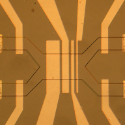What is obvious may not be trivial
The two-dimensional electron gas (2DEG) in the presence of a large magnetic field is a fertile playground for macroscopic quantum phenomena. Bilayer 2DEGs in which each layer is separated by a sufficiently thin insulating barrier are also found to exhibit an unusual collective phase when the total density of electrons is equal to the degeneracy, , of a single Landau level (or a “filling factor” of 1).
Writing in Physical Review B, Aaron Finck and colleagues at Caltech and Bell Laboratories find that electron tunneling between layers in a bilayer 2DEG is proportional to the sample area. The result may seem intuitive and even trivial but it contradicts existing theory. In particular, in such bilayers, each electron in a layer is bound to a virtual hole in the opposite layer, forming an exciton. It therefore costs no energy for electrons (or holes) to tunnel between layers, similar to the tunneling across a Josephson junction between two superconductors. Yet many theoretical models assumed this effect was localized to the edges of the layers where the current is injected and retrieved, rather than the entire area of the device.
Resolving the discrepancy between this experiment and theory is difficult because both correlations within the layers and between them are of equal importance. Disorder is also likely to play an important role, but even theoretical work that takes disorder into account cannot explain the Caltech group’s new experiments. –- Sarma Kancharla





